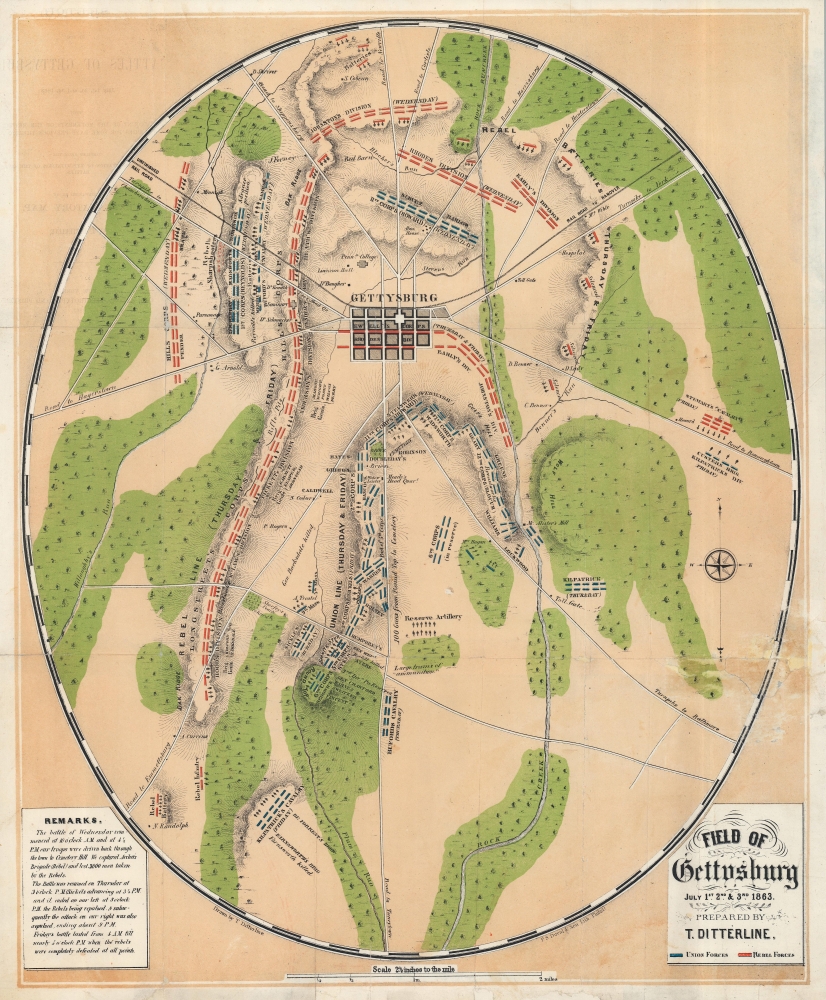This item has been sold, but you can get on the Waitlist to be notified if another example becomes available, or purchase a digital scan.
1863 Ditterline Map of the American Civil War Battle of Gettysburg
FieldGettysburg-ditterline-1863$875.00

Title
Field of Gettysburg. July 1st, 2nd, and 3rd.
1863 (dated) 19 x 15.5 in (48.26 x 39.37 cm)
1863 (dated) 19 x 15.5 in (48.26 x 39.37 cm)
Description
An impressive feat of battle cartography, this is Theodore Ditterline's landmark map of the American Civil War Battle of Gettysburg. The battle took place from July 1 - July 3, 1863, and represents the 'high water mark' of the Confederacy. Ditterline manages to encapsulate all three days of fighting onto one sheet in a coherent manner. A Gettysburg resident, he published this work along with a 24-page pamphlet only months after the battle.
A Closer Look
Union and Rebel battle lines appear throughout, with Union (blue) and Confederate (red) positions labeled with the commanding officer's last name, sometimes unit, and day. The seminary, Pennsylvania College, cemetery, and homes of Gettysburg residents are identified.The Battle of Gettysburg
Fought from July 1 through the 3rd, 1863, the Battle of Gettysburg was the defining moment of the American Civil War (1861 - 1865). The Confederacy began the war by advancing aggressively and successfully under the brilliant generalship of Major General Robert E. Lee (1807 - 1870). Buoyed by his May 1863 successes at the Battle of Chancellorsville (April 30 - May 6, 1863), Lee launched a grand invasion of Pennsylvania, intending to push as far as Harrisburg or potentially Philadelphia. The Union and Confederate forces first engaged at Gettysburg on July 1, 1863. The Confederates met with some initial success, seizing weakly defended but strategic ridges before reaching a stalemate. The Confederates decided to break the stalemate with an aggressive charge on the well-fortified Union position of Cemetery Ridge. Pickett's Charge, as it became known after its leader, Confederate Maj. Gen. George E. Pickett (1825 - 1875) was a disaster, incurring heavy losses and turning the tide of the battle. In subsequent engagements, Union forces again and again prevailed, forcing the Confederate army into a torturous retreat back to Virginia. The Battle of Gettysburg resulted in between 46,000 and 51,000 casualties, proving the costliest single battle in U.S. history. In the aftermath of the battle, on November 19, President Abraham Lincoln (1809 - 1865) issued the historic Gettysburg Address, redefining the purpose of the war. Pickett's Charge proved to be the Confederate high-water mark. Not only did the Confederacy lose the Battle of Gettysburg, but from this point forward, they also began to lose the war.Publication History and Census
This map was prepared by Theodore Ditterline and published in 1863 in his Sketch of the Battles of Gettysburg. We note 5 examples of this map cataloged in OCLC: Johns Hopkins University, Harvard University, the Boston Athenaeum, the Library of Congress, and Pennsylvania State University. We also note an example in the collection at Yale University. This map has appeared on the market a handful of times in the last decade in varying conditions, most comparable to the present example. This is the first time we have handled Ditterline's map, and from our research, this map is difficult to acquire in any condition.Source
Ditterline, T., Sketch of the Battles of Gettysburg, with an Explanatory Map, (New York: Alvord) 1863.
Condition
Fair. Backed on archival tissue for stability. Closed tear extending 3 inches into printed area from right margin professionally repaired on verso. Closed tear extending 3.5 inches vertically through the Union lines along Cemetery Ridge. Reinforced where previously attached to booklet. Areas of infill along some fold lines. Slight loss at a few fold intersections.
References
Yale University 774hc G33 1863D. OCLC 43788122.

